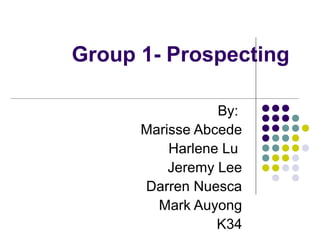
Group 1- Prospecting: The Lifeblood of Sales
- 1. Group 1- Prospecting By: Marisse Abcede Harlene Lu Jeremy Lee Darren Nuesca Mark Auyong K34
- 2. The Tree of Business Life: Prospecting - Involves locating and qualifying the individuals or businesses that have a potential to buy a product. - A person or business that might be a prospect is a lead.
- 3. - Salespeople who begin their sales careers prospecting look forward to the day when most of their sales come from present customers. - Referrals are earned by demonstrating integrity, trustfulness and character to the customer.
- 4. Sales Process? - Sales process refers to a sequential series of actions by the salesperson that leads towards the customer taking a desired action and ends with a follow-up to ensure purchase satisfaction.
- 5. The Selling Process 1. Prospecting 2. Pre-approach 3. Approach 4. Presentation 5. Trial close 6. Determine objections 7. Meet objections 8. Trial close 9. Close 10. Follow-up
- 6. Steps before the sales presentation - It all begins with prospecting - Doing a great amount of background work just like a lawyer - A good sales process involves 20% presentation, 40% preparation and 40% follow-up. - “Nothing happens until someone does some prospecting”
- 7. Prospecting – The life blood of selling - First step in the selling process - A prospect is a qualified person or organization that’s has potential to buy - It is the life blood of selling because it identifies potential customers - 2 reasons – increase sales and replace customers that will be lost over time - Find people that are MAD. Money, authority and the desire to buy?
- 8. THE LEAKING BUCKET CUSTOMER CONCEPT - New customers come into the top and leave through a hole in the bottom of the bucket. -it is always easier to sell a satisfied customer than an unsatisfied one or a prospect. -The cost of acquiring a new customer is higher than keeping a present customer. This is why service and follow-up after the sale are so important to salespeople.
- 9. WHERE TO FIND PROSPECTS -Sources of prospects can be many and varied or few and similar, depending on the service or good the salesperson sells. Naturally, persons selling different services and goods might not use the same sources for prospects.
- 10. PLANNING A PROSPECTING STRATEGY -Frequently salespeople, especially new ones, have difficulty prospecting. -Many salespeople prefer to contact prospects having similar characteristics as themselves. -To be successful, prospecting requires a strategy. Prospecting, like other activi- ties, is a skill that can be constantly improved by a dedicated salesperson.
- 11. Prospecting Methods - Actual Methods that salespeople use to obtain prospects 1. E-Prospecting on the Web -Individual -Organizations 2. Cold Canvasing 3. Endless Chain Customer Referral 4. Orphaned customers 5. Sales Lead Clubs 6. Prospect List 7. Getting published 8. Public exibitions 9. Center of Influence 10. Direct Mail 11. Telephone and Telemarketing 12. Observation 13. Networking
- 12. Prospecting Guidlines -The criteria that you should use in developing the best prospecting method. 1. CUSTOMIZE or choose a prospecting method that fits the specific needs of your individual firm -DO NOT COPY ANOTHER COMPANY'S METHOD 2. Concentrate on HIGH POTENTIAL customers first. 3. Always CALL BACK on prospects that did not buy. -Look for new customers -Do not be limited to your present customers
- 13. The Prospect Pool -A group of names gathered from various sources -Ex. Mailing List, telephone book, referrals, orphans, or existing customers. PROSPECT POOL LEAD REFERRAL CUSTOMER ORPHAN
- 14. 1. Leads - people and organizations you know nothing about or very little about. 2. Referrals - people or organizations you frequently know very little about than what you learned from the referral. 3. Orphans - company records provide your only information about these past customers. 4. Your Customers - The most important prospects for future sales.
- 15. The Referral Cycle - Provides guidelines for a salesperson to ask for referrals in four commonly faced situations. 1. The Preapproach 2. The Presentation 3. Service and Follow-up
- 16. Referral Cycle PREAPPROACH SERVICE and PRESENTATION FOLLOW-UP PROSPECT POOL PRODUCT DELIVERY
- 17. Call Reluctance Costs You Money
- 18. Call Reluctance Not wanting to contact a prospect or customer “You must admit you have call reluctance and that your call reluctance s keeping you from helping others and earning what you’re worth.” Owning up to call reluctance is the most difficult part of combating it
- 19. Obtaining the Sales Interview
- 20. Benefits of Appointment Making Telephone Appointment Plan and write down what you will say. Clearly identify yourself and your company. State the purpose of your call and briefly outline how the prospect may benefit from the interview. Prepare a brief sales message. Do not take no for an answer. Ask for an interview. Phrase your appointment request as a question.
- 21. Benefits of Appointment Making Personally Making the Appointment Believe in yourself. Develop friends in the prospect’s firms. Call at the right time on the right person. Do not waste time waiting.
- 22. Wireless E-Main Helps You Keep in Contact and Prospect
